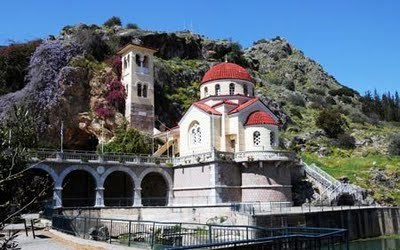 Every year, on the first Friday after Easter, the Orthodox Church celebrates the Spring of Healing. It is a feast dedicated to the Mother of God, designed to portray the role of the Virgin Mary in the work of salvation of men. The name of the Source of Healing reminds of a series of miracles done at a spring near Constantinople.
Every year, on the first Friday after Easter, the Orthodox Church celebrates the Spring of Healing. It is a feast dedicated to the Mother of God, designed to portray the role of the Virgin Mary in the work of salvation of men. The name of the Source of Healing reminds of a series of miracles done at a spring near Constantinople.
According to tradition, Leon the Great, shortly before he became a emperor, walked through a forest near Constantinople. Meets a blind old man who asks him to give him water and take him to the city. Leon will search for a spring nearby, but he will not find it.
At one point, he heard the Mother of God telling her, “You do not have to worry about, because the water is near!” Leone stepped deeper into this forest, and taking the cloudy water with his hands, he quenched the thirst of the blind and then anointed With her dark eyes. ” Leon will obey, and will find a spring from which he will give the blind to drink. He will wash his face with this water, and the blind will begin to see.
After he became king, Leon built a church near that spring. Later, Emperor Justinian (527-565), who suffered from a severe illness, healed after drinking water from this spring. As a sign of thanks, he built an even larger church. This church was destroyed by the Turks in 1453.


Over time, the water of this spring has healed many diseases and healed various wounds and sufferings.
 Believers who go to Istanbul (the new name of the ancient city of Constantinople) can worship in the Source of Healing Church. The current building is from the 19th century, but at its basement there is a chapel of the 5th century where there is still today the spring of healing water from the past.
Believers who go to Istanbul (the new name of the ancient city of Constantinople) can worship in the Source of Healing Church. The current building is from the 19th century, but at its basement there is a chapel of the 5th century where there is still today the spring of healing water from the past.
From the Spring of Healing, the waters are sanctified
Orthodox Christians come to church this day to take part in the water sanctification service, also known as Small Holy Water.
In folk talk, the holy water is also told iazma or iesme. In DEX, the word lake, iezeme, with the meaning of “ugly and evil, dimple, vision” is indicated as in DLR with unknown etymology.
An explanation is required in connection with the meaning of the word “jasmine”, “ugly and evil, evil, vision,” contrary to the original sense of “sanctified water”. The explanation is the following.
After the priest sanctified the water, he sprinkles the faithful while the troparion is singing: “Salvation, O LORD, thy people, and bless thy inheritance, and give victory to the faithful Christians upon the adversary, and keep thy people with thy cross.” Thus, it has been remembered in the people that the purpose pursued by the abomination is to cast out the “ugly and evil appearance”, that is, the evil spirit.
Healing springs in Romania

The Ghighiu Monastery is known not only by the miracle-working icon of the Virgin Mary brought here in 1958, but also by its healing spring.
 At the Dervent Monastery, where the Apostle Andrew made a miracle, there is another spring of healing water.
At the Dervent Monastery, where the Apostle Andrew made a miracle, there is another spring of healing water.
Another place where we can find a spring with healing water is the Horaicioara Monastery. Pilgrims from all over the country come to the three monasteries to receive water from these wonderful springs.

The Source of Healing – Traditions and popular beliefs
On this day, in some parts of the country, young teenagers make the juvenile covenant. This covenant was done, with or without witnesses, in the house, in the gardens, or around a blooming tree. The young people went through several ritual moments by which they made the oath: the vowing of the oath, the exchange of cola and other objects of symbolic value, usually a pot or a clay terracotta, always accompanied by a lit candle, the brotherly embrace, Eating ritual food and dancing.
Professor Ion Ghinoiu mentions that in some ethnographic areas, the ceremony is repeated annually on the same date until the infected girls and the infected boys enter the game. Linked persons, cousins, peasants, siblings, brothers of the cross, etc. met each year or, after marriage, at Pentecost. After the solemn conclusion of the covenant, children and then mature men would say to death death, cousin, cousin, cousin, and behave to one another as true brothers and sisters: they consulted in the most intimate and difficult problems in life, Shared the secrets, did not marry their sister or brother’s sister or brother, helped and defended each other up to the supreme sacrifice.
Adrian Cocosilă
